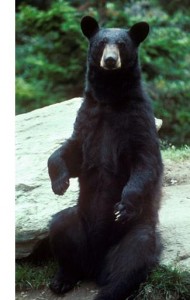THURSDAY, 24 FEBRUARY 2011
 Black bears display unusual patterns of metabolic and thermal regulation during hibernation as well as when they emerge in the spring, causing some biologists to question whether or not they really hibernate. Hibernation is a powerful way to reduce energy costs; in small mammals it involves lowered body temperatures and metabolic activity interrupted by periods of arousal and increased temperatures. However, a study based at the Institute of Arctic Biology at the University of Alaska found that hibernating black bears lack the periods of arousal. Furthermore the study, which made continuous measurements of oxygen consumption, body temperature and heart, muscle, and brain activities, showed that the bears maintained surprisingly high body temperatures during hibernation yet suppressed their metabolism to 25% of basal rates [1] .
Black bears display unusual patterns of metabolic and thermal regulation during hibernation as well as when they emerge in the spring, causing some biologists to question whether or not they really hibernate. Hibernation is a powerful way to reduce energy costs; in small mammals it involves lowered body temperatures and metabolic activity interrupted by periods of arousal and increased temperatures. However, a study based at the Institute of Arctic Biology at the University of Alaska found that hibernating black bears lack the periods of arousal. Furthermore the study, which made continuous measurements of oxygen consumption, body temperature and heart, muscle, and brain activities, showed that the bears maintained surprisingly high body temperatures during hibernation yet suppressed their metabolism to 25% of basal rates [1] .Upon emerging from hibernation, black bears maintain a reduced metabolic rate for up to three weeks. This suggests that metabolic suppression during hibernation is independent of lowered body temperature, and basal metabolic rate is not a constant but rather is physiologically controlled.
Further research may show that a torpid state via active metabolic inhibition is the primary means by which mammals can conserve energy.
Written by Rachel Berkowitz
